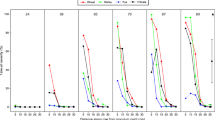Summary
Antibiotic resistant mutants 8-0 StrR, 110 TetR and 138 KanR derived from wild typeRhizobium japonicum strains were inoculated into silt loam soil to cell concentrations greater than 2×108/g of soil. Population changes were monitored using antibiotic media and strain identification was done using immunodiffusion assay on microcores of soil. Immunodiffusion bands formed by the mutant strains with homologous antisera essentially duplicated bands formed by the parent strain. Strains 110 TetR and 8-0 StrR had cross reacting antigens whereas antigens of strain 138 KanR reacted only with the homologous antiserum. Populations ofR. japonicum strains introduced into sterile soil increased over a period of four weeks under both single and mixed culture inoculations. All populations decreased by the end of six weeks and thereafter remained constant. When theseR. japonicum strains were introduced into non-sterile soil, the population did not increase over the initial population added. Population decreased gradually for two weeks and then maintained thereafter. It was possible to recover very low populations of antibiotic resistantR. japonicum strains from both sterile and unsterile soils using media containing specific antibiotics. Detection ofR. japonicum strains by immunodiffusion was accomplished only when the population was ≥109 cells/g of soil. The method using antibiotic resistant mutants permitted an evaluation of the interactions of variousR. japonicum strains in soil with respect to their survival and multiplication.
Similar content being viewed by others
References
Bassett, B., Goodman, R. N. and Novacky, A. 1977 Ultrastructure of soybean nodules I: Release of rhizobia from the infection thread. Can. J. Microbiol.23, 573–582.
Bassett, B., Goodman, R. N. and Novacky, A. 1977 Ultrastructure of soybean nodules II: Deterioration of the symbiosis in ineffective nodules. Can. J. Microbiol.23, 873–883.
Bohlool, B. B. and Schmidt, E. L. 1970 Immunofluorescent detection ofRhizobium japonicum in soils. Soil Sci.110, 229–236.
Bohlool, B. B. and Schmidt, E. L. 1973 Persistence and competition aspects ofRhizobium japonicum observed in soil by immunofluorescence microscopy. Soil Sci. Soc. Am. Proc.37, 561–564.
Brockwell, J., Schwinghamer, E. A. and Gault, R. R. 1977 Ecological studies of root-nodule bacteria introduced into field environments. V. A critical examination of the stability of antigenic and streptomycin-resistance markers for identification of strains ofRhizobium trifolii. Soil Biol. Biochem.9, 19–24.
Cole, M. A. and Elkan, G. H. 1973 Transmissible resistance to penicillin G, neomycin, and chloramphenicol inRhizobium japonicum. Antimicrob. Agents Chemother.4, 248–253.
Danso, S. K. A. and Alexander, M. 1974 Survival of two strains of Rhizobium in soil. Soil Sci. Soc. Am. Proc.38, 86–89.
Diatloff, A. 1977 Ecological studies of root nodule bacteria introduced into field environments. 6. Antigenic and symbiotic stability in Lotononis rhizobia over a 12-year period. Soil Biol. Biochem.9, 85–88.
Dudman, W. F. 1971 Antigenic analysis ofRhizobium japonicum by immunodiffusion. Appl. Microbiol.21, 973–985.
Dudman, W. F. and Brockwell, J. 1968 Ecological studies of root nodule bacteria introduced into field environments. I. A survey of field performance of clover inoculants by gel immunodiffusion serology. Aust. J. Agric. Res.19, 739–747.
Dunigan, E. P., Frey, J. P., Allen, L. A. Jr. and McMahon, A. 1972 Herbicidal effects on the nodulation ofGlycine max (L) Merill. Agron. J.64, 806–808.
Elkan, G. H. 1971 Biochemical and genetical aspects of the taxonomy ofRhizobium japonicum. Plant and Soil Spec. Vol. 85–104.
Hahn, N. J. 1966 The congo red reaction in bacteria and its usefulness in the identification of rhizobia. Can. J. Microbiol.12, 725–733.
Hamdi, Y. A. 1971 Soil water tension and the movement of rhizobia. Soil Biol. Biochem.3, 121–126.
Kremer, R. J. and Wagner, G. H. 1978 Detection of solubleRhizobium japonicum antigens in soil by immunodiffusion. Soil Biol. Biochem.9, 247–255.
Levin, R. A. and Montgomery, M. P. 1974 Symbiotic effectiveness of antibiotic-resistant mutants ofRhizobium japonicum. Plant and Soil41, 669–676.
Marshall, K. C. 1975 Clay mineralogy in relation to survival of soil bacteria. Ann. Rev. Phytopathol.13, 359–373.
Nelson, L. M. Jr. and Hedricks, H. G. 1976 Influence of an experimental herbicide on soil nitrogen fixing bacteria and other microorganisms. Soil Sci.122, 206–215.
Odeyemi, O. and Alexander, M. 1977 Use of fungicide-resistant rhizobia for legume inoculation. Soil Biol. Biochem.9, 247–251.
Read, Margaret, P. 1953 The establishment of serologically identifiable strains ofRhizobium trifolii in field soils in competition with the native microflora. J. Gen. Microbiol.9, 1–14.
Schmidt, E. L. 1974 Quantitative and ecological study of microorganisms in soil by immunofluorescence. Soil Sci.118, 141–149.
Schmidt, E. L., Bankole, R. O. and Bohlool, B. B. 1968 Fluorescent antibody approach to the study of rhizobia in soil. J. Bacteriol.95, 1987–1992.
Schwinghamer, E. A. and Dudman, W. F. 1973 Evaluation of spectinomycin resistance as a marker for ecological studies withRhizobium spp. J. Appl. Bacteriol.36, 263–272.
Škrdleta, V. 1969 Serological analysis of eleven strains ofRhizobium japonicum. Antonie van Leeuwenhoek J. Microbiol. Serol.35, 77–83.
Smith, R. S. and Miller, R. H. 1974 Interactions betweenRhizobium japonicum and soybean rhizosphere bacteria. Agron. J.66, 654–567.
Thompson, J. A. and Vincent, J. M. 1967 Methods of detection and estimation of rhizobia in soil. Plant and Soil26, 72–84.
Vincent, J. M. 1970 A manual for the practical study of the root-nodule bacteria. International Biological Programme, Blackwell Scientific Publications, Oxford, England.
Wacek, T. J. and Brill, W. J. 1976 Simple, rapid assay for screening nitrogen-fixing ability in soybean. Crop. Sci.16, 519–523.
Weaver, R. W., Frederick, L. R. and Dumenil, L. C. 1972 Effect of soybean cropping and soil properties on numbers ofRhizobium japonicum in Iowa Soils. Soil Sci.114, 137–141.
Author information
Authors and Affiliations
Rights and permissions
About this article
Cite this article
Pugashetti, B.K., Wagner, G.H. Survival and multiplication ofRhizobium japonicum strains in silt loam. Plant Soil 56, 217–227 (1980). https://doi.org/10.1007/BF02205850
Received:
Issue Date:
DOI: https://doi.org/10.1007/BF02205850




